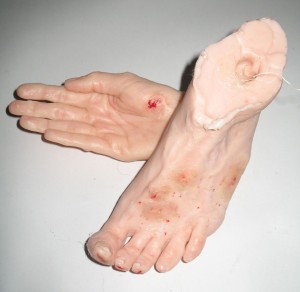 Wax votives by Sigrid Sarda, the teacher of today's workshop. Anatomical Wax Votive Making Workshop with Artist Sigrid Sarda
Date: Sunday, June 24
Time: 10 AM - 4 PM
Admission: $145 (includes $63 materials fee)
*** Limited class size; Must RSVP to morbidanatomy [at] gmail.com
This class is part of The Morbid Anatomy Art Academy
The Votive: Expressing or symbolizing a wish, desire, or vow; Offered, given, undertaken, performed or dedicated in fulfillment of or in accordance with a vow.
Anatomical votives-or replicas of diseased body parts left at a holy place either in hopes of curing ailments or in gratitude for having been healed-have been widely utilized since ancient times. Common media for votives have included terra cotta, marble, silver, and, our personal favorite, wax. In this class, expert wax worker and artist Sigrid Sarda will teach students to create an uncannily lifelike wax votive of the body part of their choice. Each student will leave class with a finished wax votive as well as a knowledge of mold making, wax craft, and the history and meaning of the anatomical votive.
Students are encouraged to focus on an afflicted body part for which they seek relief, or, if they are lacking any unfortunate ailments-be it an ear ache, psoriasis, or that pesky cutaneous horn-to choose a body part that is symbolic to them in anticipation of a particular wish or prayer. Symbolic meanings include the hand which traditionally equates to justice, strength, pledge of faith, power or sincerity, and the foot equating to humility and respect. If that doesn’t suffice we’ll make one up as we go along.
Using an ancient formula created by practitioners of wax modeling, you will create an object for your prayer. The steps taken to reach the desired goal are: first, casting your body part into alginate and creating a negative mold; second, pouring wax into the mold; and finally, demold and clean your votive.
The class will begin with a short talk on the history of votives followed by casting the the body part of your choice. Next, we will take a short break for lunch. following which we will de-mold and clean your lovely wax votive. Please dress casually (it’s a bit messy and very fun). All you need is to bring yourself. All materials are provided, and you get to leave class with your very own votive.
Sigrid Sarda is self taught in the art of ceroplastics. She has been featured on such programs as The Midnight Archive and will be appearing on TV’s Oddities this June. She will be showing her work in London this fall. You can find out more here, here and here.
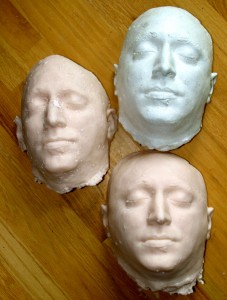 Life masks by Sigrid Sarda, teacher of today's workshop. Life and Death Mask Making Workshop with Artist Sigrid Sarda
Date: Sunday, June 3
Time: 10 AM - 4 PM
Admission: $100 (includes $40 materials fee)
*** Limited class size; Must RSVP to morbidanatomy [at] gmail.com
This class is part of The Morbid Anatomy Art Academy
For many centuries and in many civilizations, artisans have created what are called “Life Masks” or “Death Masks” cast from the faces of the famous or the infamous to preserve their likeness-living or dead-for posterity. In this class, students will learn to create their very own Life Masks working with alginate-a non-toxic seaweed-based mold making product that is easy on the skin-and plaster. Students will pair up and cast one another, but don’t be alarmed; the workshop’s instructor Ms. Sarda assures us that you will love this experience, and that most everyone who has been cast comes out feeling relaxed to the point of jello, with the extra insentive of a free facial. All materials are included, and each student will leave class home with their face immortalized in plaster.
The day’s schedule:
- Partnering up and casting
- Adding plaster to the negative mold
- An hour break for lunch (give or take depending on how fast the plaster dries)
- Demolding and cleaning the cast
- Touching up any imperfections in the plaster cast
Warning: If you are someone who is extremely claustrophobic, this is not for you. Dress casually and have fun!
Sigrid Sarda is self taught in the art of ceroplastics. She has been featured on such programs as The Midnight Archive and will be appearing on TV’s Oddities this June. She will be showing her work in London this fall. You can find out more here, here and here.
 "Field Urchin," 2011, by Saul Chernick; drawn from a series of studies in which he attempted to impose the proportions of cherubs onto horses. A 4-part class with Artist Saul Chernick, M.F.A., Rutgers University
Dates: Mondays June 25, July 2, July 9 & July 16th (4 consecutive Mondays)
Time: 6:30-9:00 PM
Class Fee: $120
***Class size limited to 15; Must RSVP to morbidanatomy [at] gmail.com
This class is part of The Morbid Anatomy Art Academy
Contemporary artist and arts educator Saul Chernick is renowned for gorgeous artworks featuring convincingly corporeal depictions of imaginary or mythical creatures rendered in the style of Medieval and early Renaissance woodcuts from Northern Europe. Observatory is very pleased to announce a new workshop developed by Saul Chernick specially for the Morbid Anatomy Art Academy. In this class, Chernick will teach students-via illustrated lectures and in-class projects including paper puppets and bestiary pages-”to use observational and imaginative drawing skills in tandem to capture the essential qualities of their subject” and “learn to draw animals (real, mythic, and otherwise) with greater skill and sensitivity.”
Full class description follows; you can see more of Chernick’s fantastic work by clicking here. Class size limited to 15; Please RSVP to morbidanatomy [at] gmail.com.
Course Description
Open to artists of all levels, the goal of this workshop is help participants learn to draw animals (real, mythic, and otherwise) with greater skill and sensitivity. Through exercises in drawing and paper puppetry, participants will gain a deeper understanding of the skeletal/muscular structures of most mammals, reptiles, and birds. Participants will also learn to use observational and imaginative drawing skills in tandem to capture the essential qualities of their subject and create works of convincing visual fiction!
What to expect
- Participants will cull images from the web to create a dossier on the animal(s) that interest them
- Participants will fashion movable paper puppets to understand how their chosen animal moves
- Participants will draw studies of the skeletal and muscular structures of animals
- Participants will use the medium of their choice to create a Bestiary page entry that depicts an animal situated in an environment
Materials
What to bring to the first class:
- Choose 1-3 animals and gather pictures on the web. Be sure to get images of their skeletons in profile. Please print these as they may be hard to use on a phone screen.
- 3-5 sheets of Bristol Board Paper 9″ x 12″ or larger
- Pencils & erasers
- Scissors
- Xacto or utility knife
- Glue
What to bring for subsequent classes:
- White or tinted drawing paper 16″ x 20″ or 18″ x 24″
- Tracing paper (same size as drawing paper)
- Mechanical and/or regular pencils (2h, hb, 2b, 4b)
Optional:
- Markers, watercolors, gouache, ink, brushes, chalk/oil pastels, colored pencils, Caran D’Ache, collage papers, etc (we’ll discuss further in detail!)
Saul Chernick, M.F.A., Rutgers University, is a visual artist and educator. Chernick has exhibited internationally in galleries and museums including the Aldrich Museum of Contemporary Art, the Bronx Museum of Art, the Jewish Museum of Art, as well as Max Protetch and Meulensteen Galleries in New York City. He has taught art for the public school system, the 92nd Street Y, Cooper Union, Parson’s School of Design, and the Museum of Modern Art. He is currently the Professional Development Coordinator for the Joan Mitchell Foundation where he coaches New York artists in teaching art to young people throughout city. His work can be seen at www.saulchernick.com.
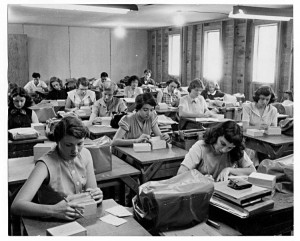 Organizational workshop for creative types with Oliver Burkeman of The Guardian Organizational workshop for creative types with Oliver Burkeman of The Guardian
Date: Monday, April 30th
Time: 7:30-9:30 PM
Admission: $20
*** Limited class size; Must RSVP to morbidanatomy [at] gmail.com to be added to class list
This class is part of The Morbid Anatomy Art Academy
Do you hunger to climb the corporate ladder with ruthless efficiency, leaving your rivals in the dust as you pursue your relentless quest for wealth and power? Hopefully not, but that doesn’t mean you can’t borrow some tactics from such people and apply them to your own ends; to that end, today’s class-taught by Oliver Burkeman, compulsive to-do-list-maker and journalist for London’s Guardian-will teach creatives, freelancers, and artists how to plan and manage multiple projects, better plan their time, and, in general, feel less overwhelmed by juggling a variety of projects at one time.
Burkeman has spent much of the last few years researching and reporting on self-help culture, including the fascinating history of the “how to succeed” publishing genre, and motivational gurus from Dale Carnegie to Stephen Covey, and sifting the wheat from the chaff. (There’s a lot of chaff.) Drawing on this research, this workshop will explore some fundamental principles of getting organized, managing multiple projects, overcoming procrastination, time management, and being both more productive and less stressed in the kinds of sprawling artistic/creative/freelance lives that don’t get much attention in The Seven Habits of Highly Effective People. No cringe-inducing motivational speeches will be given; no Magic Systems for Instant Success will be promoted. Instead, we’ll plunder from the world of the grinning gurus the bits that actually work – so that you’ll leave equipped with a toolkit of immediately useable ways to do the stuff you’re already doing, and the projects you’re planning, with greater efficiency and ease.
The class will begin with an illustrated lecture and conclude with a workshop segment where students will be guided in an application of the principles; participants are encouraged to come to class with a project to organize.
Oliver Burkeman in a writer based in Brooklyn with an unhealthy interest in filing systems. He writes features and a weekly column on psychology for the (London) Guardian. His book The Antidote: Happiness for People Who Can’t Stand Positive Thinking will be published by Faber & Faber in the fall.
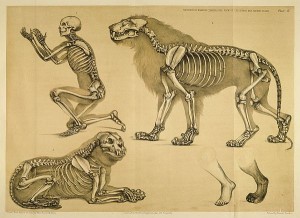 "A Comparative View of the Human and Animal Frame" by Benjamin Waterhouse Hawkins, 1860 A weekend workshop with Chris Muller, NYU’s Tisch School of the Arts
Dates: Saturday May 5 & Sunday May 6
Time: 1 - 4 PM
Fee: $75 (includes museum admission)
*** Class size limited to 15; Must RSVP to morbidanatomy [at] gmail.com
This class is part of The Morbid Anatomy Art Academy
Using animal and human anatomy as a jumping off point, this course will look at the ground-level, first principles of drawing as representation. Focusing mainly on mammal anatomy, we’ll look at the basic shared forms between humans and other animals, how these forms dictate movement, and how to express those forms.
Saturday’s class will be held at Observatory, where with the aid of several skeletons we’ll look at basic structures, sprinkling our exploration with odd facts and observations. Messy investigatory drawings will ensue.
Sunday’s class will be a field trip to the American Museum of Natural History, where applying the principles of Saturday’s class we’ll create beautiful drawings of the animals on display. Then, mastery attained, we will stride forth into the world, better artists and better people.
Materials
Saturday
- Sketchbook or sketchpad, 11 X 14 or larger
- B and HB pencils
- Colored pencils, in the reds and blues and browns
- Hand pencil sharpener
- Erasers
Sunday
- All of the above, with perhaps a portable sketchbook in place of the larger sketchpad
- Portable folding stool (optional)
Chris Muller is an artist and exhibit designer based in Brooklyn. He has designed exhibits for the Whitney Museum of American Art, the Museum for African Art, the Children’s Museum of Manhattan, and many others. He has designed sets for Laurie Anderson, Alvin Ailey Dance Theater, the Atlantic Theater Company, and others. He teaches drawing and digital painting at NYU’s Tisch School of the Arts.
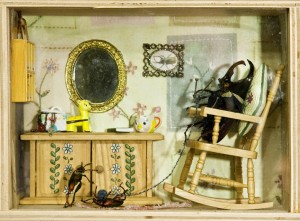 Anthropomorphic Insect Shadowbox by Daisy Tainton, teacher of today's workshop With Daisy Tainton, Former Senior Insect Preparator at the American Museum of Natural History
Dates: Saturday, May 12; Saturday, June 30; July 7; July 21; August 11
Time: 1 - 4 PM
Admission: $65
***Must RSVP to morbidanatomy [at] gmail.com to be added to class list
This class is part of The Morbid Anatomy Art Academy
Rhinoceros beetles: nature’s tiny giants. Adorable, with their giant heads and tiny legs, and wonderful antler-like protrusions. If you think they would be even more adorable drinking tiny beers and holding tiny fishing poles, we have the perfect class for you! In today’s workshop, students will learn to make-and leave with their own!-shadowbox dioramas featuring carefully positioned beetles doing nearly anything you can imagine. An assortment of miniature furniture and foods will be made available to decorate your habitat, but students are strongly encouraged to bring any dollhouse props they would like to use. 1:12 scale is generally best.
Daisy Tainton was formerly Senior Insect Preparator at the American Museum of Natural History, and has been working with insects professionally for several years. Eventually her fascination with insects and love of Japanese miniature food items naturally came together, resulting in cute and ridiculous museum-inspired yet utterly unrealistic dioramas. Beetles at the dentist? Beetles eating pie and knitting sweaters? Even beetles on the toilet? Why not?
 Anthropomorphic Insect Shadowbox by Daisy Tainton, teacher of today's workshop With Daisy Tainton, Former Senior Insect Preparator at the American Museum of Natural History
Date: Sunday, May 20
Time: 1 - 4 PM
Admission: $65
***Sold out; new class here
This class is part of The Morbid Anatomy Art Academy
Rhinoceros beetles: nature’s tiny giants. Adorable, with their giant heads and tiny legs, and wonderful antler-like protrusions. If you think they would be even more adorable drinking tiny beers and holding tiny fishing poles, we have the perfect class for you! In today’s workshop, students will learn to make-and leave with their own!-shadowbox dioramas featuring carefully positioned beetles doing nearly anything you can imagine. An assortment of miniature furniture and foods will be made available to decorate your habitat, but students are strongly encouraged to bring any dollhouse props they would like to use. 1:12 scale is generally best.
Daisy Tainton was formerly Senior Insect Preparator at the American Museum of Natural History, and has been working with insects professionally for several years. Eventually her fascination with insects and love of Japanese miniature food items naturally came together, resulting in cute and ridiculous museum-inspired yet utterly unrealistic dioramas. Beetles at the dentist? Beetles eating pie and knitting sweaters? Even beetles on the toilet? Why not?
 Anthropomorphic Insect Shadowbox by Daisy Tainton, teacher of today's workshop With Daisy Tainton, Former Senior Insect Preparator at the American Museum of Natural History
Date: Saturday, April 28
Time: 1 - 4 PM
Admission: $65
********SOLD OUT; New class on May 20th; more here
This class is part of The Morbid Anatomy Art Academy
Rhinoceros beetles: nature’s tiny giants. Adorable, with their giant heads and tiny legs, and wonderful antler-like protrusions. If you think they would be even more adorable drinking tiny beers and holding tiny fishing poles, we have the perfect class for you! In today’s workshop, students will learn to make-and leave with their own!-shadowbox dioramas featuring carefully positioned beetles doing nearly anything you can imagine. An assortment of miniature furniture and foods will be made available to decorate your habitat, but students are strongly encouraged to bring any dollhouse props they would like to use. 1:12 scale is generally best.
Daisy Tainton was formerly Senior Insect Preparator at the American Museum of Natural History, and has been working with insects professionally for several years. Eventually her fascination with insects and love of Japanese miniature food items naturally came together, resulting in cute and ridiculous museum-inspired yet utterly unrealistic dioramas. Beetles at the dentist? Beetles eating pie and knitting sweaters? Even beetles on the toilet? Why not?
 Date 1: Tuesday, May 29 (Sold out) Date 1: Tuesday, May 29 (Sold out)
Date 2: Tuesday, June 26 (Sold out)
Date 3: Tuesday, July 10 (Sold out)
Date 4: Tuesday, July 24 (Sold out)
Date 5: Tuesday, August 7 (Sold out)
Time: 7 PM-11 PM
Admission: $60
Presented by Morbid Anatomy
***Email morbidanatomy [at] gmail.com to be added to wait list; all classes now sold out
This class is part of the Morbid Anatomy Art Academy
Anthropomorphic taxidermy-the practice of mounting and displaying taxidermied animals as if they were humans or engaged in human activities-was a popular art form during the Victorian and Edwardian eras. The best known practitioner of the art form is British taxidermist Walter Potter who displayed his pieces-which included such elaborate tableaux as The Death of Cock Robin, The Kitten Wedding, and The Kitten Tea Party-in his own museum of curiosities.
On Tuesday November 29th, please join Morbid Anatomy and taxidermist, tattoo artist and educator Susan Jeiven for a beginners class in anthropomorphic taxidermy. All materials-including a mouse for each student-will be provided, and each class member will leave at the end of the day with their own anthropomorphic taxidermied mouse. Students are invited to bring any miniature items with which they might like to dress or decorate their new friend; some props and miniature clothing will also be provided by the teacher. A wide variety of sizes and colors of mice will be available.
No former taxidermy experience is required.
Also, some technical notes:
- We use NO harsh or dangerous chemicals.
- Everyone will be provided with gloves.
- All animals are disease free.
- Although there will not be a lot of blood or gore, a strong constitution is necessary; taxidermy is not for everyone.
- All animals were already dead, nothing was killed for this class. All mice used are feeder animals for snakes and lizards and would literally be discarded if not sold.
- Please do not bring any dead animals with you to the class
You can contact Sue with any more questions by clicking here.
 Anthropomorphic Insect Shadowbox by Daisy Tainton, teacher of today's workshop With Daisy Tainton, Former Senior Insect Preparator at the American Museum of Natural History
Date: Sunday, February 12
Time: 1 - 4 PM
Admission: $65
*** SOLD OUT; Additional class added on March 24th; link here
Rhinoceros beetles: nature’s tiny giants. Adorable, with their giant heads and tiny legs, and wonderful antler-like protrusions. If you think they would be even more adorable drinking tiny beers and holding tiny fishing poles, we have the perfect class for you! In today’s workshop, students will learn to make-and leave with their own!-shadowbox dioramas featuring carefully positioned beetles doing nearly anything you can imagine. An assortment of miniature furniture and foods will be made available to decorate your habitat, but students are strongly encouraged to bring any dollhouse props they would like to use. 1:12 scale is generally best.
Daisy Tainton was formerly Senior Insect Preparator at the American Museum of Natural History, and has been working with insects professionally for several years. Eventually her fascination with insects and love of Japanese miniature food items naturally came together, resulting in cute and ridiculous museum-inspired yet utterly unrealistic dioramas. Beetles at the dentist? Beetles eating pie and knitting sweaters? Even beetles on the toilet? Why not?
|



 Organizational workshop for creative types with Oliver Burkeman of The Guardian
Organizational workshop for creative types with Oliver Burkeman of The Guardian

 Date 1: Tuesday, May 29 (Sold out)
Date 1: Tuesday, May 29 (Sold out)